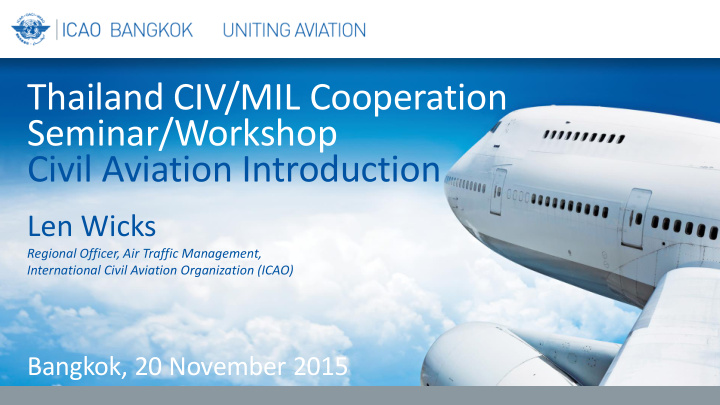



Thailand CIV/MIL Cooperation Seminar/Workshop Civil Aviation Introduction Len Wicks Regional Officer, Air Traffic Management, International Civil Aviation Organization (ICAO) Bangkok, 20 November 2015
Contents • Introducing ICAO • Civil Aviation Systems • Conclusions
Introducing ICAO • The International Civil Aviation Organization (ICAO): – is a specialised agency of the United Nations, overseeing the safety and efficiency of civil aviation – is headquartered in Montreal, Canada – has seven regional offices
Introducing ICAO • The ICAO Regional Office: – was established in May 1948 at Melbourne, Australia as the Far East and Pacific Office, then moved to Bangkok in 1955 – facilities are kindly provided by the Royal Thai government – has a Sub-Office in Beijing, China
Introducing ICAO • The ICAO Asia/Pacific (APAC) Regional Office: – is responsible for 38 States, and 49 Flight Information Regions (FIRs), plus liaison with USA and France – has 31%+ of air travel in its APAC Region – manages a region subject to regular natural disasters, and diversity in political governance and economic development
Introducing ICAO • The International Civil Aviation Organization (ICAO): – does not regulate the military – determines and disseminate best civil practices – serves as a platform to promote international cooperation – uses its regional framework to bring civil and military authorities together and raise awareness – assist States in the implementation of ICAO policy, provisions, air navigation plan
Introducing ICAO • However, Article 3 (d) of the Convention on International Civil Aviation (‘the ICAO Convention) states : The Contracting States undertake, when issuing regulations for their state aircraft, that they will have due regard for the safety of navigation of civil aircraft. Note: Articles to the Convention are expanded in the Annexes to the Convention (Annex 2 = Rules of the Air, Annex 11 = Air Traffic Services)
Introducing ICAO • Also, Article 3 bis states: a) The contracting States recognize that every State must refrain from resorting to the use of weapons against civil aircraft in flight and that, in case of interception, the lives of persons on board and the safety of aircraft must not be endangered. This provision shall not be interpreted as modifying in any way the rights and obligations of States set forth in the Charter of the United Nations.
Introducing ICAO • Below the Convention are Standards and Recommended Practices (SARPs), and Guidance Material (GM) – Standards = ‘necessary’ for safety/regularity of air navigation – Recommended Practices = ‘desirable’ – Guidance Material = non-regulatory, related to SARPs and Procedures for Air Navigation Services (PANS)
Civil Aviation System • Civil aircraft: – account for ~75% of all aircraft – include about 20,000 aircraft flying commercially worldwide (35,000 new aircraft in 20 years)
Civil Aviation Systems • Commercial civil aircraft: – growth rates in the Asia/Pacific are ~7% per annum (only the Middle East has a higher growth rate) – account for ~8-12,000 flights in the air at any moment 2012 operations
Civil Aviation Systems • Commercial civil aircraft: – growth rates in the Asia/Pacific are ~6.7% per annum (only the Middle East has a higher growth rate) – account for ~8-12,000 flights in the air at any moment 2020 operations
Civil Aviation Systems • Airspace is classified to denote its air traffic service level – Class A, B, C, D and E are controlled – Class F (advisory) and G are uncontrolled
Civil Aviation Systems • Special Use Airspace (SUA) may be established: – in uncontrolled or controlled airspace to superimpose additional flight requirements – but not all SUA is associated with military operations, and besides prohibited, restricted and danger areas, some States have other types (e.g.: MOA)
Civil Aviation Systems • Operations are regulated by civil aviation authorities (CAAs): – decrees, regulations, rules, etc. to meet ICAO SARPs and national policies are developed by appropriate government ministries and CAAs (sometimes called DGCAs)
Civil Aviation Systems – service providers (such as AOT and AEROTHAI) are regulated by CAAs but resourcing and empowerment of the regulator can be a problem in some cases – some service responsibilities can be unclear (such as Search and Rescue (SAR)
Conclusions • ICAO is a key body to provide a level of harmonisation for international air travel, even more so in the Asia/Pacific due to the lack of a pan-regional body • While the military are not bound by civil SARPs, there are articles in the ‘ICAO Convention’ that apply to the military • Civil aviation constitutes the majority of aviation activity
Recommend
More recommend